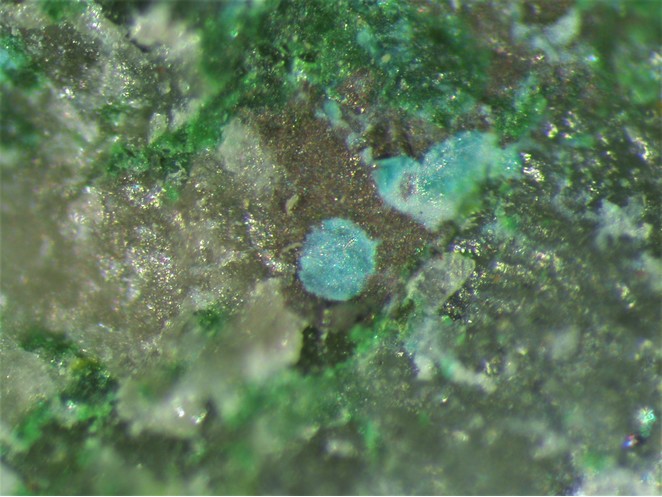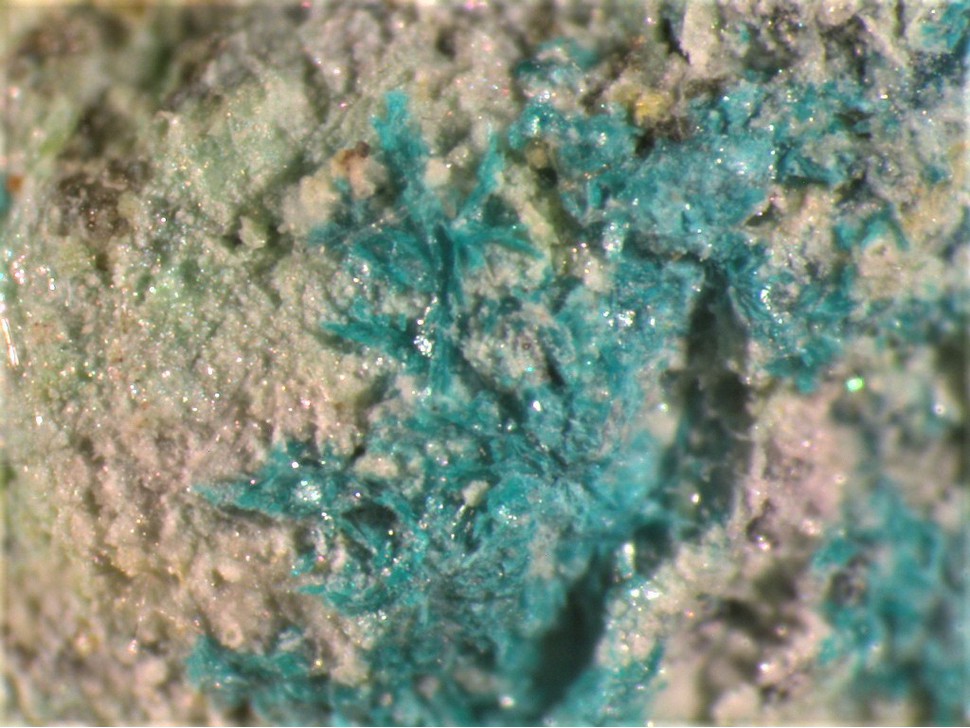Mojaveite
A valid IMA mineral species
This page is currently not sponsored. Click here to sponsor this page.
About Mojaveite
Formula:
Cu6[Te6+O4(OH)2](OH)7Cl
Colour:
Greenish-blue; sky blue to medium greenish
Lustre:
Adamantine, Pearly, Dull
Hardness:
1
Specific Gravity:
4.886 (Calculated)
Crystal System:
Trigonal
Name:
Named for the Mohave desert in which the type locality is found.
Co-Type Localities:
ⓘ Aga Mine, Otto Mountain, Baker, Soda Mountains, Silver Lake Mining District, San Bernardino County, California, USA
ⓘ Bird Nest drift, Otto Mountain, Baker, Soda Mountains, Silver Lake Mining District, San Bernardino County, California, USA
ⓘ Blue Bell Mine, Zzyzx, Soda Mountains, Silver Lake Mining District, San Bernardino County, California, USA
ⓘ Bird Nest drift, Otto Mountain, Baker, Soda Mountains, Silver Lake Mining District, San Bernardino County, California, USA
ⓘ Blue Bell Mine, Zzyzx, Soda Mountains, Silver Lake Mining District, San Bernardino County, California, USA
Structurally related to bluebellite (IMA 2013-121). Second Cu-Te-O-H-Cl mineral after tlalocite.
The structure is based on Cu6MX14 brucite-like layers, with M and X in mojaveite being Te and (O,OH,Cl), respectively.
The structure is based on Cu6MX14 brucite-like layers, with M and X in mojaveite being Te and (O,OH,Cl), respectively.
Unique Identifiers
Mindat ID:
46069
Long-form identifier:
mindat:1:1:46069:7
GUID
(UUID V4):
(UUID V4):
333c74c3-225c-44d3-934a-b41cd4158b90
IMA Classification of Mojaveite
Approved
Approval year:
2013
Classification of Mojaveite
7.BB.80
7 : SULFATES (selenates, tellurates, chromates, molybdates, wolframates)
B : Sulfates (selenates, etc.) with additional anions, without H2O
B : With medium-sized cations
7 : SULFATES (selenates, tellurates, chromates, molybdates, wolframates)
B : Sulfates (selenates, etc.) with additional anions, without H2O
B : With medium-sized cations
Mineral Symbols
As of 2021 there are now IMA–CNMNC approved mineral symbols (abbreviations) for each mineral species, useful for tables and diagrams.
| Symbol | Source | Reference |
|---|---|---|
| Moj | IMA–CNMNC | Warr, L.N. (2021). IMA–CNMNC approved mineral symbols. Mineralogical Magazine, 85(3), 291-320. doi:10.1180/mgm.2021.43 |
Pronunciation of Mojaveite
Pronunciation:
| Play | Recorded by | Country |
|---|---|---|
| Jolyon Ralph | United Kingdom |
Physical Properties of Mojaveite
Adamantine, Pearly, Dull
Comment:
May be adamantine, pearly or dull
Colour:
Greenish-blue; sky blue to medium greenish
Streak:
Pale greenish blue
Hardness:
1 on Mohs scale
Comment:
~1
Tenacity:
Sectile
Cleavage:
Perfect
on {001}
on {001}
Fracture:
Irregular/Uneven
Density:
4.886 g/cm3 (Calculated)
Comment:
Based on the empirical formulae and unit-cell dimensions
Optical Data of Mojaveite
Type:
Uniaxial (-)
Pleochroism:
Visible
Comments:
O (greenish blue) >> E (light greenish blue).
Comments:
n=1.95 from Gladstone-Dale relationship (n value couldn't be measured directly)
Chemistry of Mojaveite
Mindat Formula:
Cu6[Te6+O4(OH)2](OH)7Cl
Common Impurities:
Pb
Crystallography of Mojaveite
Crystal System:
Trigonal
Class (H-M):
3 - Pyramidal
Space Group:
R3
Setting:
R3
Cell Parameters:
a = 8.316(2) Å, c = 13.202(6) Å
Ratio:
a:c = 1 : 1.588
Unit Cell V:
790.7 ų
Z:
3
Morphology:
Irregular aggregates of plates flattened on {001}, often curved, which rarely show a hexagonal outline, and also occurs as compact balls, from sky blue to medium greenish blue in colour. Aggregates and balls are up to 0.5 mm in size.
Crystal Structure
Load
Unit Cell | Unit Cell Packed
2x2x2 | 3x3x3 | 4x4x4
Unit Cell | Unit Cell Packed
2x2x2 | 3x3x3 | 4x4x4
Show
Big Balls | Small Balls | Just Balls | Spacefill
Polyhedra Off | Si Polyhedra | All Polyhedra
Remove metal-metal sticks
Big Balls | Small Balls | Just Balls | Spacefill
Polyhedra Off | Si Polyhedra | All Polyhedra
Remove metal-metal sticks
Display Options
Black Background | White Background
Perspective On | Perspective Off
2D | Stereo | Red-Blue | Red-Cyan
Black Background | White Background
Perspective On | Perspective Off
2D | Stereo | Red-Blue | Red-Cyan
View
CIF File Best | x | y | z | a | b | c
CIF File Best | x | y | z | a | b | c
Rotation
Stop | Start
Stop | Start
Labels
Console Off | On | Grey | Yellow
Console Off | On | Grey | Yellow
Data courtesy of the American Mineralogist Crystal Structure Database. Click on an AMCSD ID to view structure
| ID | Species | Reference | Link | Year | Locality | Pressure (GPa) | Temp (K) |
|---|---|---|---|---|---|---|---|
| 0020532 | Mojaveite | Mills S J, Kampf A R, Christy A G, Housley R M, Rossman G R, Reynolds R E, Marty J (2014) Bluebellite and mojaveite, two new minerals from the central Mojave Desert, California, USA Mineralogical Magazine 78 1325-1340 | 2014 | Blue Bell claims, San Bernardino County, California, USA | 0 | 293 |
CIF Raw Data - click here to close
X-Ray Powder Diffraction
Powder Diffraction Data:
| d-spacing | Intensity |
|---|---|
| 4.403 Å | (91) |
| 2.672 Å | (28) |
| 2.512 Å | (100) |
| 2.110 Å | (27) |
| 1.889 Å | (34) |
| 1.570 Å | (39) |
| 1.481 Å | (34) |
| 1.338 Å | (14) |
Comments:
very similar to bluebellite
Geological Environment
Paragenetic Mode(s):
| Paragenetic Mode | Earliest Age (Ga) |
|---|---|
| Stage 7: Great Oxidation Event | <2.4 |
| 47a : [Near-surface hydration of prior minerals] | |
| 47e : [Vanadates, chromates, manganates] | |
| 47g : [Halogen-bearing surface weathering minerals] | |
| Stage 10b: Anthropogenic minerals | <10 Ka |
| 55 : Anthropogenic mine minerals |
Type Occurrence of Mojaveite
Co-Type Localities:
ⓘ Aga Mine, Otto Mountain, Baker, Soda Mountains, Silver Lake Mining District, San Bernardino County, California, USA
ⓘ Bird Nest drift, Otto Mountain, Baker, Soda Mountains, Silver Lake Mining District, San Bernardino County, California, USA
ⓘ Blue Bell Mine, Zzyzx, Soda Mountains, Silver Lake Mining District, San Bernardino County, California, USA
ⓘ Bird Nest drift, Otto Mountain, Baker, Soda Mountains, Silver Lake Mining District, San Bernardino County, California, USA
ⓘ Blue Bell Mine, Zzyzx, Soda Mountains, Silver Lake Mining District, San Bernardino County, California, USA
General Appearance of Type Material:
Mojaveite occurs as greenish-blue plates flattened on {001}, which rarely show a hexagonal outline
Place of Conservation of Type Material:
Cotype material is deposited in the collections of the Mineral Sciences Department, Natural History Museum of Los Angeles County, 900 Exposition Boulevard, Los Angeles, California 90007, USA, catalogue numbers 64091 and 64092 (Blue Bell claims) and 64093
Geological Setting of Type Material:
Formed from the decomposition of the primary minerals hessite and chalcopyrite under mildly acidic conditions.
Associated Minerals at Type Locality:
Synonyms of Mojaveite
Common Associates
Associated Minerals Based on Photo Data:
| 2 photos of Mojaveite associated with Khinite | Pb2+Cu2+3[Te6+O6](OH)2 |
| 2 photos of Mojaveite associated with Chrysocolla | Cu2-xAlx(H2-xSi2O5)(OH)4 · nH2O, x < 1 |
| 2 photos of Mojaveite associated with Kettnerite | CaBiCO3OF |
| 2 photos of Mojaveite associated with Quartz | SiO2 |
| 2 photos of Mojaveite associated with Timroseite | Pb2Cu5(TeO6)2(OH)2 |
| 1 photo of Mojaveite associated with Goethite | α-Fe3+O(OH) |
| 1 photo of Mojaveite associated with Hemimorphite | Zn4Si2O7(OH)2 · H2O |
| 1 photo of Mojaveite associated with Cerussite | PbCO3 |
| 1 photo of Mojaveite associated with Mcalpineite | Cu3(Te6+O6) |
| 1 photo of Mojaveite associated with Wulfenite | Pb(MoO4) |
Related Minerals - Strunz-mindat Grouping
| 7.BB. | Brumadoite | Cu3(Te6+O4)(OH)4 · 5H2O |
| 7.BB. | Iskandarovite | Sb6O7(SO4)2 |
| 7.BB. | Novikovite | (NH4)4Mo6+2Mo5+2O8(SO4)5 |
| 7.BB.10 | Hauckite | Fe3+3(Mg,Mn2+)24Zn18(SO4)4(CO3)2(OH)81 |
| 7.BB.15 | Antlerite | Cu3(SO4)(OH)4 |
| 7.BB.20 | Dolerophanite | Cu2(SO4)O |
| 7.BB.25 | Brochantite | Cu4(SO4)(OH)6 |
| 7.BB.25 | Ramaccioniite | Cu4[SeO4](OH)6 |
| 7.BB.30 | Vergasovaite | Cu3(SO4)(MoO4,SO4)O |
| 7.BB.30 | Cupromolybdite | Cu3O(MoO4)2 |
| 7.BB.35 | Klebelsbergite | Sb4O4(SO4)(OH)2 |
| 7.BB.35 | Tavagnascoite | Bi4O4(SO4)(OH)2 |
| 7.BB.40 | Schuetteite | Hg2+3(SO4)O2 |
| 7.BB.45 | Paraotwayite | Ni(OH)2-x(SO4,CO3)0.5x |
| 7.BB.50 | Xocomecatlite | Cu3(TeO4)(OH)4 |
| 7.BB.55 | Pauflerite | (V4+O)SO4 |
| 7.BB.60 | Grandviewite | Cu3Al2(SO4)(OH)10 · H2O |
| 7.BB.65 | Timroseite | Pb2Cu5(TeO6)2(OH)2 |
| 7.BB.70 | Glikinite | Zn3O(SO4)2 |
| 7.BB.85 | Paratimroseite | Pb2Cu4(TeO6)2(H2O)2 |
Fluorescence of Mojaveite
Non-fluorescent
Other Information
Notes:
Raman bands [cm-1]: 694, 654 (poorly resolved); 624, 611, 254
Health Risks:
No information on health risks for this material has been entered into the database. You should always treat mineral specimens with care.
Internet Links for Mojaveite
mindat.org URL:
https://www.mindat.org/min-46069.html
Please feel free to link to this page.
Please feel free to link to this page.
Search Engines:
External Links:
Mineral Dealers:
References for Mojaveite
Reference List:
Williams, P. A., Hatert, F., Pasero, M., Mills, S. J. (2014) New minerals and nomenclature modifications approved in 2014, CNMNC Newsletter No 20. Mineralogical Magazine, 78 (3) 549-558 doi:10.1180/minmag.2014.078.3.05
Localities for Mojaveite
Locality List
 - This locality has map coordinates listed.
- This locality has map coordinates listed.
 - This locality has estimated coordinates.
ⓘ - Click for references and further information on this occurrence.
? - Indicates mineral may be doubtful at this locality.
- This locality has estimated coordinates.
ⓘ - Click for references and further information on this occurrence.
? - Indicates mineral may be doubtful at this locality.
 - Good crystals or important locality for species.
- Good crystals or important locality for species.
 - World class for species or very significant.
(TL) - Type Locality for a valid mineral species.
(FRL) - First Recorded Locality for everything else (eg varieties).
- World class for species or very significant.
(TL) - Type Locality for a valid mineral species.
(FRL) - First Recorded Locality for everything else (eg varieties).
All localities listed without proper references should be considered as questionable.
USA | |
| Marek Chorazewicz (2022) |
| MarekC pers. coll. 2017 |
| Williams et al. (2014) +1 other reference |
| Marek Chorazewicz (2019) | |
| Williams et al. (2014) +2 other references |
| Thorne (n.d.) | |
| Thorne (n.d.) | |
| Housley R. | |
| Thorne (n.d.) | |
| Thorne (n.d.) | |
| Williams et al. (2014) +3 other references |
| Collected by and in the collection of ... | |
| Thorne (n.d.) | |
| Kampf et al. (2022) |
| MarekC (2019) |
Quick NavTopAbout MojaveiteUnique IdentifiersIMA Classification Classification Mineral SymbolsPronunciation Physical Properties Optical Data Chemistry Crystallography Crystal StructureX-Ray Powder DiffractionGeological EnvironmentType Occurrence SynonymsCommon AssociatesStrunz-MindatFluorescence Other InformationInternet Links References Localities Locality List






 symbol to view information about a locality.
The
symbol to view information about a locality.
The 





Ridge Ledge prospect, Otto Mountain, Baker, Soda Mountains, Silver Lake Mining District, San Bernardino County, California, USA